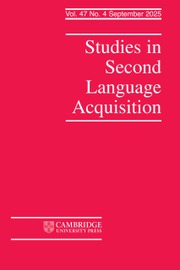Crossref Citations
This article has been cited by the following publications. This list is generated based on data provided by
Crossref.
Henry, Nicholas
Culman, Hillah
and
VanPatten, Bill
2009.
MORE ON THE EFFECTS OF EXPLICIT INFORMATION IN INSTRUCTED SLA.
Studies in Second Language Acquisition,
Vol. 31,
Issue. 04,
p.
559.
Handwerker, Brigitte
2009.
Sprachunterricht als Instruktion zur Inputverarbeitung.
Zeitschrift für Literaturwissenschaft und Linguistik,
Vol. 39,
Issue. 1,
p.
96.
Culman, Hillah
Henry, Nicholas
and
VanPatten, Bill
2009.
The Role of Explicit Information in Instructed SLA: An On‐Line Study with Processing Instruction and German Accusative Case Inflections.
Die Unterrichtspraxis/Teaching German,
Vol. 42,
Issue. 1,
p.
19.
Marsden, Emma
and
Chen, Hsin‐Ying
2011.
The Roles of Structured Input Activities in Processing Instruction and the Kinds of Knowledge They Promote.
Language Learning,
Vol. 61,
Issue. 4,
p.
1058.
VanPatten, Bill
and
Uludag, Onur
2011.
Transfer of training and processing instruction: From input to output.
System,
Vol. 39,
Issue. 1,
p.
44.
Ren, Hulin
and
Yang, Qin
2011.
The application of leopar in complex sentence processing.
p.
7320.
Stafford, Catherine A.
Bowden, Harriet Wood
and
Sanz, Cristina
2012.
Optimizing Language Instruction: Matters of Explicitness, Practice, and Cue Learning.
Language Learning,
Vol. 62,
Issue. 3,
p.
741.
Henshaw, Florencia
2012.
How effective are affective activities? Relative benefits of two types of structured input activities as part of a computer-delivered lesson on the Spanish subjunctive.
Language Teaching Research,
Vol. 16,
Issue. 3,
p.
393.
Zyzik, Eve
2012.
The Encyclopedia of Applied Linguistics.
Russell, Victoria
2012.
Learning Complex Grammar in the Virtual Classroom: A Comparison of Processing Instruction, Structured Input, Computerized Visual Input Enhancement, and Traditional Instruction.
Foreign Language Annals,
Vol. 45,
Issue. 1,
p.
42.
VanPatten, Bill
and
Borst, Stefanie
2012.
The Roles of Explicit Information and Grammatical Sensitivity in Processing Instruction: Nominative‐Accusative Case Marking and Word Order in German L2.
Foreign Language Annals,
Vol. 45,
Issue. 1,
p.
92.
2012.
Language Teaching Research and Language Pedagogy.
p.
349.
Saito, Kazuya
2013.
REEXAMINING EFFECTS OF FORM-FOCUSED INSTRUCTION ON L2 PRONUNCIATION DEVELOPMENT.
Studies in Second Language Acquisition,
Vol. 35,
Issue. 1,
p.
1.
Santamaria, Kindra D.
Muñoz, Maria L.
Atkins, Jenny L.
Hobbs, Dianne R.
and
O’Donald, Karla
2013.
A preliminary investigation into the application of processing instruction as therapy for aphasia in Spanish speakers.
Journal of Communication Disorders,
Vol. 46,
Issue. 4,
p.
338.
Collentine, Joseph
2013.
The Handbook of Spanish Second Language Acquisition.
p.
270.
Dekeyser, Robert
and
Prieto Botana, Goretti
2013.
The Handbook of Spanish Second Language Acquisition.
p.
447.
VanPatten, Bill
Collopy, Erin
Price, Joseph E.
Borst, Stefanie
and
Qualin, Anthony
2013.
Explicit Information, Grammatical Sensitivity, and the First‐Noun Principle: A Cross‐Linguistic Study in Processing Instruction.
The Modern Language Journal,
Vol. 97,
Issue. 2,
p.
506.
White, Justin P.
and
DeMil, Andrew J.
2013.
TRANSFER-OF-TRAINING EFFECTS IN PROCESSING INSTRUCTION.
Studies in Second Language Acquisition,
Vol. 35,
Issue. 3,
p.
519.
김정은
2013.
Relationships of Form-focused Instruction, Target Complexity, and Implicit and Explicit Knowledge.
English Teaching,
Vol. 68,
Issue. 2,
p.
29.
Baleghizadeh, Sasan
and
Saharkhiz, Arash
2014.
The Impact of Processing Instruction on the Recognition and Production of English Derivational Affixes Among EFL Learners.
Sage Open,
Vol. 4,
Issue. 4,


